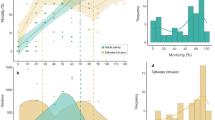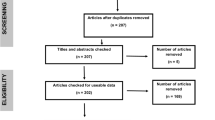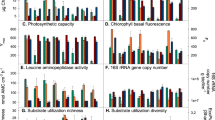Abstract
Climate and land-use change drive a suite of stressors that shape ecosystems and interact to yield complex ecological responses (that is, additive, antagonistic and synergistic effects). We know little about the spatial scales relevant for the outcomes of such interactions and little about effect sizes. These knowledge gaps need to be filled to underpin future land management decisions or climate mitigation interventions for protecting and restoring freshwater ecosystems. This study combines data across scales from 33 mesocosm experiments with those from 14 river basins and 22 cross-basin studies in Europe, producing 174 combinations of paired-stressor effects on a biological response variable. Generalized linear models showed that only one of the two stressors had a significant effect in 39% of the analysed cases, 28% of the paired-stressor combinations resulted in additive effects and 33% resulted in interactive (antagonistic, synergistic, opposing or reversal) effects. For lakes, the frequencies of additive and interactive effects were similar for all spatial scales addressed, while for rivers these frequencies increased with scale. Nutrient enrichment was the overriding stressor for lakes, with effects generally exceeding those of secondary stressors. For rivers, the effects of nutrient enrichment were dependent on the specific stressor combination and biological response variable. These results vindicate the traditional focus of lake restoration and management on nutrient stress, while highlighting that river management requires more bespoke management solutions.
This is a preview of subscription content, access via your institution
Access options
Access Nature and 54 other Nature Portfolio journals
Get Nature+, our best-value online-access subscription
$29.99 / 30 days
cancel any time
Subscribe to this journal
Receive 12 digital issues and online access to articles
$119.00 per year
only $9.92 per issue
Buy this article
- Purchase on Springer Link
- Instant access to full article PDF
Prices may be subject to local taxes which are calculated during checkout




Similar content being viewed by others
Data availability
The data on the regression model outputs and the underlying paired-stressor response data are available at GitHub: https://github.com/sebastian-birk/MultiStressorImpacts.
Code availability
The R script is available at GitHub: https://github.com/sebastian-birk/MultiStressorImpacts.
References
Ormerod, S. J., Dobson, M., Hildrew, A. G. & Townsend, C. R. Multiple stressors in freshwater ecosystems. Freshw. Biol. 55, 1–4 (2010).
Côté, I. M., Darling, E. S. & Brown, C. J. Interactions among ecosystem stressors and their importance in conservation. Proc. R. Soc. B 283, 20152592 (2016).
van Dijk, G. M., van Liere, L., Admiraal, W., Bannink, B. A. & Cappon, J. J. Present state of the water quality of European rivers and implications for management. Sci. Total Environ. 145, 187–195 (1994).
Richardson, J. et al. Effects of multiple stressors on cyanobacteria abundance varies with lake type. Glob. Change Biol. 24, 5044–5055 (2018).
Schäfer, R. B., Kühn, B., Malaj, E., König, A. & Gergs, R. Contribution of organic toxicants to multiple stress in river ecosystems. Freshw. Biol. 61, 2116–2128 (2016).
Schinegger, R., Palt, M., Segurado, P. & Schmutz, S. Untangling the effects of multiple human stressors and their impacts on fish assemblages in European running waters. Sci. Total Environ. 573, 1079–1088 (2016).
Folt, C. L. et al. Synergism and antagonism among multiple stressors. Limnol. Oceanogr. 44, 864–877 (1999).
Nõges, P. et al. Quantified biotic and abiotic responses to multiple stress in freshwater, marine and ground waters. Sci. Total Environ. 540, 43–52 (2016).
Piggott, J. J., Townsend, C. R. & Matthaei, C. D. Reconceptualizing synergism and antagonism among multiple stressors. Ecol. Evol. 5, 1538–1547 (2015).
Jackson, M. C., Loewen, C. J. G., Vinebrooke, R. D. & Chimimba, C. T. Net effects of multiple stressors in freshwater ecosystems: a meta-analysis. Glob. Change Biol. 22, 180–189 (2016).
De Laender, F. Community- and ecosystem-level effects of multiple environmental change drivers: beyond null model testing. Glob. Change Biol. 24, 5021–5030 (2018).
Skjelkvåle, B. L. et al. Regional scale evidence for improvements in surface water chemistry 1990–2001. Environ. Pollut. 137, 165–176 (2005).
Reid, A. J. et al. Emerging threats and persistent conservation challenges for freshwater biodiversity. Biol. Rev. 94, 849–873 (2019).
Palmer, M. A., Menninger, H. L. & Bernhardt, E. River restoration, habitat heterogeneity and biodiversity: a failure of theory or practice? Freshw. Biol. 55, 205–222 (2010).
Vinebrooke, R., Cottingham, K. & Norberg, M. Impacts of multiple stressors on biodiversity and ecosystem functioning: the role of species co‐tolerance. Oikos 3, 451–457 (2004).
Schäfer, R. B. & Piggott, J. J. Advancing understanding and prediction in multiple stressor research through a mechanistic basis for null models. Glob. Change Biol. 24, 1817–1826 (2018).
Thorp, J. H., Thoms, M. C. & Delong, M. D. The riverine ecosystem synthesis: biocomplexity in river networks across space and time. River Res. Appl. 22, 123–147 (2006).
Brucet, S. et al. Fish diversity in European lakes: geographical factors dominate over anthropogenic pressures. Freshw. Biol. 58, 1779–1793 (2013).
Feld, C. K. et al. Disentangling the effects of land use and geo-climatic factors on diversity in European freshwater ecosystems. Ecol. Indic. 60, 71–83 (2016).
European Waters: Assessment of Status and Pressures 2018 (European Environment Agency, 2018); https://www.eea.europa.eu/publications/state-of-water/
Jeppesen, E. et al. Lake responses to reduced nutrient loading—an analysis of contemporary long-term data from 35 case studies. Freshw. Biol. 50, 1747–1771 (2005).
Hering, D. et al. Assessment of European rivers with diatoms, macrophytes, invertebrates and fish: a comparative metric-based analysis of organism response to stress. Freshw. Biol. 51, 1757–1785 (2006).
Griffen, B. D., Belgrad, B. A., Cannizzo, Z. J., Knotts, E. R. & Hancock, E. R. Rethinking our approach to multiple stressor studies in marine environments. Mar. Ecol. Prog. Ser. 543, 273–281 (2016).
Davies, B. R., Biggs, J., Williams, P. J., Lee, J. T. & Thompson, S. A comparison of the catchment sizes of rivers, streams, ponds, ditches and lakes: implications for protecting aquatic biodiversity in an agricultural landscape. Hydrobiologia 597, 7–17 (2008).
Fuller, I. C. & Death, R. G. The science of connected ecosystems: what is the role of catchment-scale connectivity for healthy river ecology? Land Degrad. Dev. 29, 1413–1426 (2018).
Benda, L. et al. The network dynamics hypothesis: how channel networks structure riverine habitats. Bioscience 54, 413–427 (2004).
Liess, M. et al. Effects of Pesticides in the Field (Society of Environmental Toxicology and Chemistry, 2005).
Price, K. J. & Carrick, H. J. Effects of experimental nutrient loading on phosphorus uptake by biofilms: evidence for nutrient saturation in mid-Atlantic streams. Freshw. Sci. 35, 503–517 (2016).
McCall, S. J., Hale, M. S., Smith, J. T., Read, D. S. & Bowes, M. J. Impacts of phosphorus concentration and light intensity on river periphyton biomass and community structure. Hydrobiologia 792, 315–330 (2017).
Birk, S. in Multiple Stress in River Ecosystems: Status, Impacts and Prospects for the Future (eds Sabater, S. et al.) 235–253 (Academic Press, 2019); https://doi.org/10.1016/B978-0-12-811713-2.00014-5
Birk, S. et al. Three hundred ways to assess Europe’s surface waters: an almost complete overview of biological methods to implement the Water Framework Directive. Ecol. Indic. 18, 31–41 (2012).
Moss, B. et al. Allied attack: climate change and eutrophication. Inland Waters 1, 101–105 (2011).
Richardson, J. et al. The response of cyanobacteria and phytoplankton abundance to warming, extreme rainfall events and nutrient enrichment. Glob. Change Biol. 25, 3365–3380 (2019).
Jeppesen, E. et al. Impacts of climate warming on lake fish community structure and potential effects on ecosystem function. Hydrobiologia 646, 73–90 (2010).
Monteith, D. T. et al. Dissolved organic carbon trends resulting from changes in atmospheric deposition chemistry. Nature 450, 537–540 (2007).
Graneli, W. in Encyclopedia of Lakes and Reservoirs (eds Bengtsson, L. et al.) 117–119 (Springer Netherlands, 2012); https://doi.org/10.1007/978-1-4020-4410-6_256
Segner, H., Schmitt-Jansen, M. & Sabater, S. Assessing the impact of multiple stressors on aquatic biota: the receptor’s side matters. Environ. Sci. Technol. 48, 7690–7696 (2014).
Baattrup-Pedersen, A. & Riis, T. Macrophyte diversity and composition in relation to substratum characteristics in regulated and unregulated Danish streams. Freshw. Biol. 42, 375–385 (1999).
Schneider, S. C. et al. Unravelling the effect of flow regime on macroinvertebrates and benthic algae in regulated versus unregulated streams. Ecohydrology 11, e1996 (2018).
de Zwart, D. & Posthuma, L. Complex mixture toxicity for single and multiple species: proposed methodologies. Environ. Toxicol. Chem. 24, 2665–2676 (2005).
Busch, W. et al. Micropollutants in European rivers: a mode of action survey to support the development of effect-based tools for water monitoring. Environ. Toxicol. Chem. 35, 1887–1899 (2016).
Malaj, E. et al. Organic chemicals jeopardize the health of freshwater ecosystems on the continental scale. Proc. Natl Acad. Sci. USA 111, 9549–9554 (2014).
Hering, D. et al. Managing aquatic ecosystems and water resources under multiple stress—an introduction to the MARS project. Sci. Total Environ. 503, 10–21 (2015).
Moe, S. J., Dudley, B. & Ptacnik, R. REBECCA databases: experiences from compilation and analyses of monitoring data from 5,000 lakes in 20 European countries. Aquat. Ecol. 42, 183–201 (2008).
Moe, S. J., Schmidt-Kloiber, A., Dudley, B. J. & Hering, D. The WISER way of organising ecological data from European rivers, lakes, transitional and coastal waters. Hydrobiologia 704, 11–28 (2013).
Sabater, S., Ludwig, R. & Elosegi, A. in Multiple Stress in River Ecosystems: Status, Impacts and Prospects for the Future (eds Sabater, S. et al.) 1–22 (Academic Press, 2019); https://doi.org/10.1016/B978-0-12-811713-2.00001-7
Liess, M. & von der Ohe, P. C. Analyzing effects of pesticides on invertebrate communities in streams. Environ. Toxicol. 24, 954–965 (2005).
von der Ohe, P. C. & Goedkoop, W. Distinguishing the effects of habitat degradation and pesticide stress on benthic invertebrates using stressor-specific metrics. Sci. Total Environ. 444, 480–490 (2013).
Lyche Solheim, A. et al. A new broad typology for rivers and lakes in Europe: development and application for large-scale environmental assessments. Sci. Total Environ. 697, 134043 (2019).
Box, G. E. P. & Cox, D. R. An analysis of transformations. J. R. Stat. Soc. B 26, 211–252 (1964).
R Core Team R: A Language and Environment for Statistical Computing v.3.6.1 (R Foundation for Statistical Computing, 2019); http://www.r-project.org/index.html
Dormann, C. F. et al. Methods to account for spatial autocorrelation in the analysis of species distributional data: a review. Ecography (Cop.) 30, 609–628 (2007).
Nakagawa, S. & Schielzeth, H. A general and simple method for obtaining R 2 from generalized linear mixed-effects models. Methods Ecol. Evol. 4, 133–142 (2013).
Acknowledgements
This work was supported by the MARS project (Managing Aquatic Ecosystems and Water Resources under Multiple Stress) funded under the 7th EU Framework Programme, Theme 6 (Environment including Climate Change), contract no. 603378 (http://www.mars-project.eu). Further support was received through the ILES (SAW-2015-IGB-1) and BIBS (BMBF 01LC1501G) projects. Partner organizations provided 25% cofunding through their institutional budgets. We thank J. Strackbein, J. Lorenz and L. Mack for their support.
Author information
Authors and Affiliations
Contributions
D.C., L.C., B.M.S., S.B., L.B., S.J.T. and D.H. conceptualized the study. D.C. and S.B. curated the data. D.H., L.C. and S.B. acquired the funding and administered the project. A.B., A.G., A.S., B.M.S., C.A., C.G.-C., C.P., D.d.Z., D.G., E.B.-K., F.C., G.P., J.J.R., J.R., J.T., J.U.L., K.R., K.S., L.P., L.S., M.C.U., M.J., N.K., N.W., P.B., P.S., P.C.v.d.O., R.B.S., R.-M.C., R.S., S.A., S.B., S.C.S., S.J.M., S.L., S.P., S.J.T., T.B., U.I. and U.M. provided the data and/or conducted the formal analysis. A.B.-P., A.L.S., D.G., E.B.-K., E.J., H.F., J.M.S., J.R., L.C., L.S., M.O.G., P.B., S.A., S.C.S., S.S. and W.G. conducted the experimental investigations. S.B., D.H., B.M.S., M.O.G. and D.C. wrote the manuscript. H.E.A., M.B., A.D.B., A.C.C., C.K.F., M.T.F., M.O.G., L.G., J.H., M.K., P.N., T.N., S.J.O., Y.P., B.S., M.V. and the aforementioned authors reviewed the manuscript and provided the necessary amendments.
Corresponding author
Ethics declarations
Competing interests
The authors declare no competing interests.
Additional information
Publisher’s note Springer Nature remains neutral with regard to jurisdictional claims in published maps and institutional affiliations.
Supplementary information
Supplementary Information
Supplementary Tables 1 and 2, and references.
Rights and permissions
About this article
Cite this article
Birk, S., Chapman, D., Carvalho, L. et al. Impacts of multiple stressors on freshwater biota across spatial scales and ecosystems. Nat Ecol Evol 4, 1060–1068 (2020). https://doi.org/10.1038/s41559-020-1216-4
Received:
Accepted:
Published:
Issue Date:
DOI: https://doi.org/10.1038/s41559-020-1216-4
This article is cited by
-
Long-term wetland biomonitoring highlights the differential impact of land use on macroinvertebrate diversity in Dongting Lake in China
Communications Earth & Environment (2024)
-
High-throughput characterization of bacterial responses to complex mixtures of chemical pollutants
Nature Microbiology (2024)
-
Ecological thresholds of Odonata larvae to anthropogenic disturbances in neotropical savanna headwater streams
Hydrobiologia (2024)
-
Dual effects of drying and urban pollution on leaf litter decomposition and shredder consumption in permanent and intermittent streams
Hydrobiologia (2024)
-
Predicting macroinvertebrate average score per taxon (ASPT) at water quality monitoring sites in Japanese rivers
Environmental Science and Pollution Research (2024)



